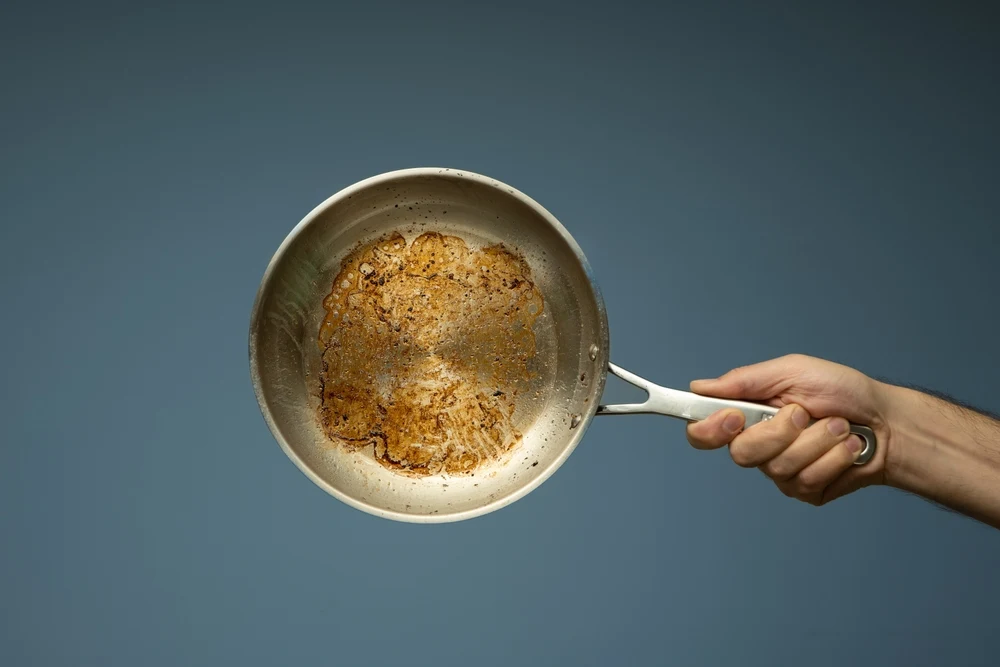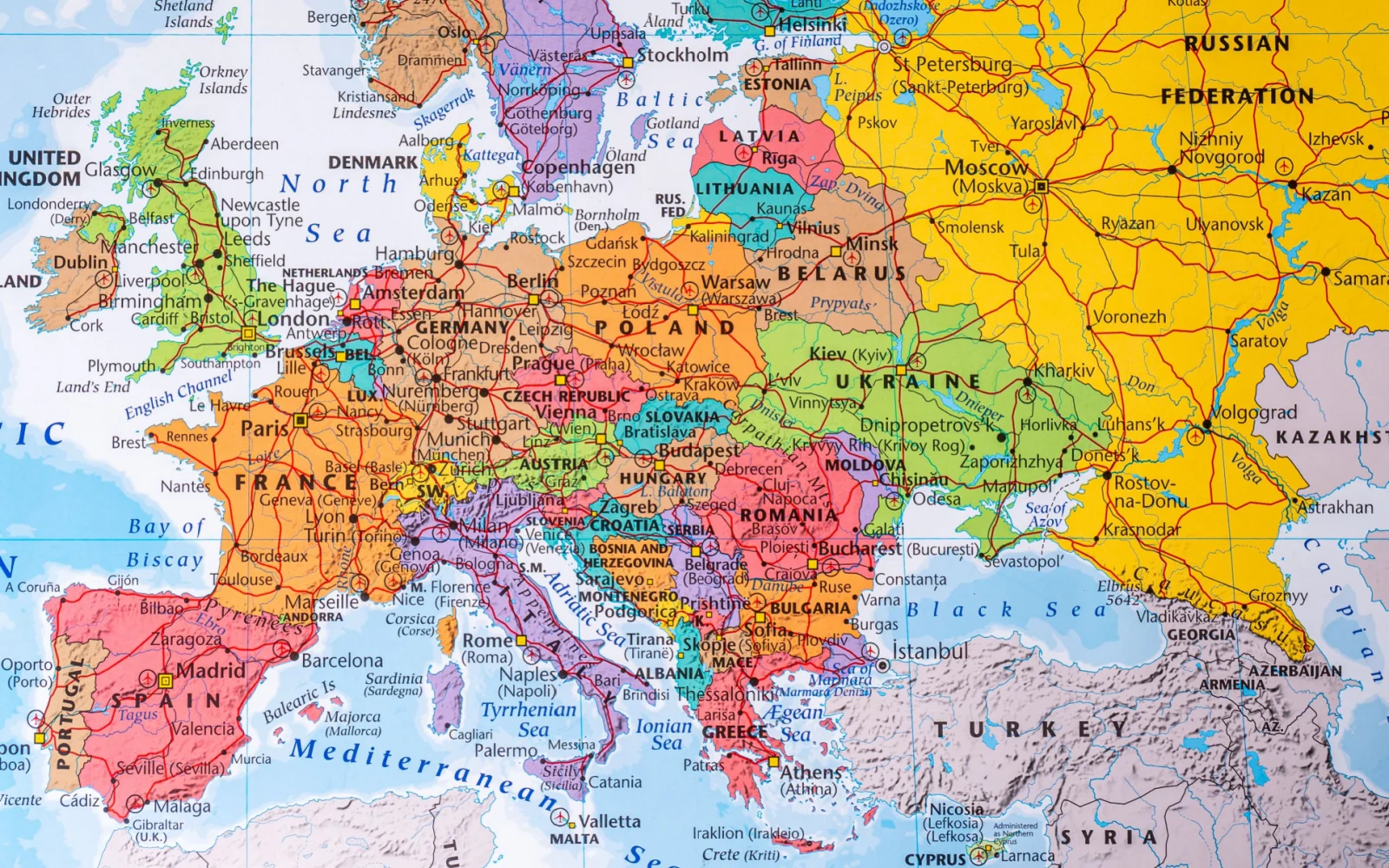Why is Europe like a frying pan?
Europe is humorously compared to a frying pan due to its shape when outlined on maps, resembling one if you exclude Scandinavia and flatten it somewhat. However, this comparison is more of a jest, and Europe’s true essence lies in its historical and cultural diversity, making it more like a melting pot than a frying pan.
In today’s post, we’ll teach you your next punny one-liner, as well as drop some knowledge about the wonderful world of Europe. Read on to learn more about Europe’s history and makeup, traveling there, and a few FAQs to make trip planning easier.
Why Europe Is Like a Frying Pan

Octavian Lazar/Shutterstock
In the classic vein of “What did Sir Lancelot wear to bed?” (a knightgown) and “What did the buffalo say to his kid when dropping him off at school?” (bye, son!) comes another golden oldie:
Why is Europe like a frying pan?
The answer: because it has Greece at the bottom.
Yes, it’s as simple as that. Naturally, Greece is far from the only country in this melting pot of a continent, though it is one of the most renowned – in the modern era as well as the ancient world.
The Perfect Metaphor? More Like A Melting Pot
If you look at an outline of Europe, it sometimes looks a little like a frying pan. That assumes you conveniently leave Scandinavia off and flatten it out somewhat – the whole Earth Is Not To Scale Because It’s Round thing can really help here sometimes.
However, in general, Europe neither looks nor acts like a frying pan. A better metaphor is a melting pot, because it has seen the widespread blending of cultures and genes for millennia now.
Europe was a land of ice for many thousands of years, where humans and Neanderthals met and blended and fought, with humans eventually coming out on top.
It then saw the Agricultural Revolution, millennia of farming and metalsmithing, and the rise of empires. The name “Europa” comes to us out of ancient history.
“As a conceptual construct, Europa, as the more learned of the ancient Greeks first conceived it, stood in sharp contrast to both Asia and Libya, the name then applied to the known northern part of Africa,” explains Encyclopedia Brittanica.
“Literally,” the encyclopedia continues, “Europa is now thought to have meant ‘Mainland,’ rather than the earlier interpretation, ‘Sunset.’ It appears to have suggested itself to the Greeks, in their maritime world, as an appropriate designation for the extensive northerly lands that lay beyond.”
That “beyond” continued to change in form and shape for several more millennia, and is today one of the seven continents of the world as we know it.
Out of the Frying Pan and Into the Shire
Did you know that JRR Tolkien’s beloved Shire, land o’ hobbits, was based on rural England? But the tranquil Shire landscape could just as easily apply to that of many countries in Europe, from pastoral France and Switzerland to bucolic Romania and Bulgaria.
It contains either 44 or 50 countries, depending on whom you ask and their definition of a country (and you may see other numbers as well).
According to Nations Online, “Europe is shared by 50 countries. By the conventional definition, there are 44 sovereign states or nations in Europe. Not included are several countries namely Turkey, which occupies only a small part of East Thrace on the European Balkan Peninsula.”
Additionally, the site rules out Cyprus, the Faroe Islands, Greenland, Kosovo, and Western Kazakhstan as countries in their own right, though they are geopolitical bodies on the European continent.
Today, more than 746 million people live in Europe, 448 million of them living within the European Union, a group of member countries that share legislation, currency, and open borders.
Wherever you go in Europe, though, you’re sure to love traveling there.
What to Know About Traveling in Europe

Allard One/Shutterstock
Traveling in Europe is a dream of many. The romantic architecture, abundant ruins, and fabulous food make this a dream destination for travelers from the Americas to Asia, Africa to Australia, and beyond.
If you’re thinking of planning a trip to Ye Olde Frying Pan, here are a few basic things to know:
- The Schengen Area makes border crossing easy. If you like the idea of road-tripping through Europe without restriction, then plan a trip to the Schengen Area. This group of 27 countries won’t ask for your passport as you cross borders, making it easier for you to get around by car, bus, train, and even air.
- You can stay up to 90 days in the Schengen Area: Your time in Schengen territory is capped at 90 out of every 180 days, unless you have a visa.
- Pack light: You might think you want that extra pair of shoes, but do you want it bad enough to show up an hour earlier at the airport, stand in line, pay to check your bag, then get an ulcer when the airline loses it? I didn’t think so.
- Let your credit card company know you’ll be traveling: You might know that you’re headed off on an epic adventure, but your credit card company has to assume when charges start appearing in Lithuania that something is amiss. Always let your bank know ahead of time that you’re leaving the country with plastic in tow.
- Look up partner ATMs for your bank: This will save you from paying unnecessary ATM fees in Europe.
Frequently Asked Questions

frantic00/Shutterstock
Here are some frequently asked questions about Europe and the various kitchenware metaphors that apply to it:
Why is Europe like a frying pan?
Okay, so you want the quick version: Why is Europe like a frying pan? Because it has Greece at the bottom.
Is Europe a good place to travel on any budget?
Yes, Europe is a great place to travel no matter how much money you have! While it has a reputation for being expensive, it doesn’t have to be. All that’s required is for you to put some thought into trip planning ahead of time, making budget-conscious decisions along the way.
For instance, you can find hostels for $20 a night in most countries, often much less. You can get a Eurail pass, which according to the website, lets you “Travel by train at your own pace and connect to over 30,000 destinations in 33 countries.” You can eat out of grocery stores and corner cafes rather than restaurants.
Of course, if you have more money to spend, so much the better!
When should I go to Europe?
When you go to Europe depends on where you want to go. Europe covers 37 degrees of latitude, covering a huge range of climates along the way: subarctic, tundra, highland, humid continental, marine, humid subtropical, Mediterranean, and semiarid.
If you’re headed to a country with continental weather – say, the interior of Spain – you’ll want to avoid the summer, when it’s hot as the dickens. And unless you’re obsessed with skiing during the midnight sun, probably don’t go to Northern Scandinavia in January.
The most popular times to travel to Europe include the spring and fall, when tourism numbers are low but weather is pleasant across most of its breadth. Summer is a good time for Mediterranean countries, assuming you have some money to spend competing with tourists.
And winter? Winter is nice if you like to ski. The Swiss Alps are a fan favorite but there are many other mountain ranges and popular destinations for winter sports, such as Romania. Winter can also be nice if you’re traveling to the Mediterranean islands, which maintain temps in the 60s or so – though you’ll still need a sweater.
Traveling to the Frying Pan: Final Thoughts
If you’re ready for an adventure, then Europe might be the ticket.
This frying pan of a continent offers dozens of countries, hundreds of beautiful and often ancient cities, and countless wondrous experiences from which to choose. Don’t wait to use our other resources to start planning your trip today!



